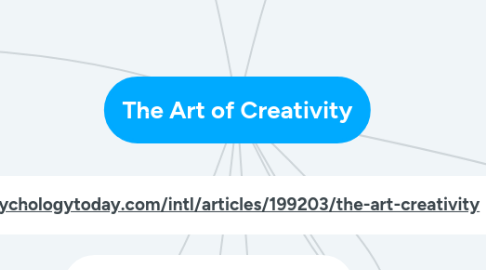
1. https://www.psychologytoday.com/intl/articles/199203/the-art-creativity
2. Letting Go
2.1. Approacheas
2.1.1. Letting go physically
2.1.1.1. Dancing
2.1.1.2. Stretching
2.1.2. Letting go mentally
2.1.2.1. Meditating
2.1.2.2. Relaxation
2.1.2.3. Playing an instrument
2.1.2.4. Emotion
2.2. When people reflect
2.3. More creative
2.4. More expressive
2.5. Activities
3. Be Aware
3.1. Ideas for refocusing your perceptions
3.1.1. Deepening your creative capacity
3.1.1.1. Create a new pattern
3.1.1.2. Cool focus
3.1.1.3. Creative approach
3.1.2. Refocusing your perceptions
3.1.2.1. Routine changes
3.1.2.2. Think about how to change things
3.1.3. Get out of ordinary contexts
3.1.3.1. Invent a whole new pattern
4. Creative People On Creativity
4.1. Creativity is mainly beginning to see the fabric of the structure
4.2. Creative people are committed to risk
4.3. Creativity comes by breaking the rules
4.4. Creativity is cutting holes to see through.
4.5. The most important thing to get into a creative spirit is to make time every day to do it
5. Steps in creative problem-solving
5.1. 1) Preparation
5.1.1. Let your imagination roam free
5.1.2. Listen openly and well
5.1.3. Self-censorship
5.2. 2) Incubation
5.2.1. Digest all you have gathered.
5.2.2. Daydream and relax
5.3. 3) Translation
5.3.1. Take your insight and transform it into action
5.3.2. Becomes useful to you and others
6. Students: Andrew Navas; Diego Roca; Luis David Escobar; Samantha Bhor
7. Looking at things
8. Creativity in Children
8.1. Creativity killers in kids
8.1.1. Surveillance
8.1.2. Evaluation
8.1.3. Competition
8.1.4. Overcontrol
8.1.5. Pressure
8.1.6. Time
8.2. The kernel of creativity
8.2.1. Drive to explore
8.2.2. Desire
8.2.2.1. Find out about things
8.2.3. Try things out
8.2.4. Experiment with different ways
8.2.5. Handling things
8.3. State of creativity
8.3.1. Flow
8.3.1.1. Timeless moment
8.4. Enjoyment
9. Creativity at Work
9.1. Key ideas
9.1.1. Small is better
9.1.1.1. Size affects creativity
9.1.2. Climbing together
9.1.3. Vanquishing negativity
9.1.3.1. building feelings of trust
9.1.3.2. respect
9.1.4. Valuing intuition
9.1.4.1. Making intuitive decisions
9.2. Creative ideas
9.2.1. Innovations in management
9.2.2. Improvements in distribution methods
9.2.3. New ideas for financing a business
9.2.4. Elimination of restrictive job descriptions
9.3. Changes
9.3.1. Interpretation of information
9.4. Interpretation
9.4.1. Creative act
9.4.1.1. Influenced by our feelings
9.4.1.2. Trusted by others
9.4.1.3. Confidence in our own intuition
10. Inside Creativity
10.1. Creative Moments
10.1.1. Mysterious
10.1.2. Creative Spirit
10.1.3. Special areas
10.1.4. Small challenges
10.1.5. Convencional
10.1.6. Originality
10.1.7. All of our creative acts express who we are at that moment.
10.2. The ability to see things
10.2.1. Vital
10.2.2. Try to see different perspectives
10.3. Creative problem-solving
10.3.1. Mistakes
10.3.1.1. Creative people make more mistakes than their imaginative peers
10.3.2. Fail to learn
10.3.2.1. Humor
10.3.2.1.1. Disarm the inner censor
10.3.3. Take it lightly
10.3.4. Brainstorming sessions
10.3.4.1. Seed
10.3.5. Team work
10.3.5.1. Jokes
10.4. Flow
10.4.1. Full of fire
10.4.1.1. White moments
10.4.2. People are at their peak
10.4.3. Self-consciousness disappears
10.4.4. Skills + challenge
10.4.5. Time seems to pass much more quickly
10.4.6. Brain expends less energy than when they are wrestling with a problem.
